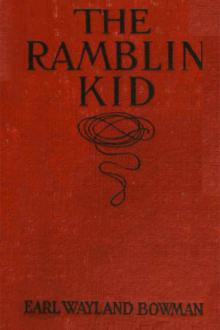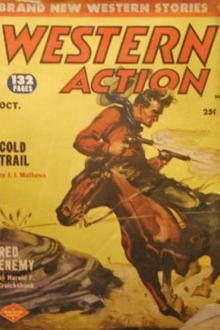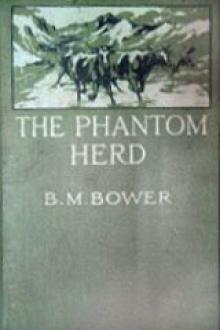Spinifex and Sand<br />A Narrative of Five Years' Pioneering and Exploration in Western Ausralia, David Wynford Carnegie [best novels in english .txt] 📗

- Author: David Wynford Carnegie
Book online «Spinifex and Sand<br />A Narrative of Five Years' Pioneering and Exploration in Western Ausralia, David Wynford Carnegie [best novels in english .txt] 📗». Author David Wynford Carnegie
From the 22nd to the 24th we saw no signs of natives. On the latter day several smokes rose during the march. So far, we had no certain knowledge of the meaning of these smokes. They might be native signals, or from fires for the purpose of burning off the old spinifex to allow young feed to grow and so attract the rats to a known locality; or it might be that the blacks were burning the country to hunt out the rats and lizards. On the 25th a sudden change took place, and we found ourselves in a small, open thicket with a coarse undergrowth of grass, and scattered about were a few boulders of decomposed granite and occasional low outcrops of rock. Several old native camps put us on the alert, and presently we found a well—a shallow hole, 7 feet deep, and 2 feet 6 inches in diameter, entirely surrounded by high spinifex. Why there should ever be water there, or how the blacks got to know of it, was a problem we could only guess at. Everything looked so dry and parched that we were in no way surprised at finding the well waterless. Prempeh had been very unwell lately, refusing to take what little feed there was to be got. A dose of sulphur and butter was administered, poured warm down his throat by me as Breaden held open his month, grasped firmly by either lip. I believe sulphur is an excellent thing for camels, and used often to treat them to the mixture, some—Satan, for example—being very partial to it. The position of this well I found to be lat. 25° 15´, long. 124° 48´; from the edge of the mulga, one hundred yards or so to the North of it, a range of rough looking hills is visible. This I named the Browne Range, after my old friends at Bayley's Reward, and the two conspicuous points I christened Mount Gordon, after Mr. Gordon Lyon, and Mount Everard, after Mr. Everard Browne, respectively.
Mount Gordon is flat-topped; and Mount Everard a double hill, a peak rising from a flat top, bears 82° from the well. This range stood out boldly from the open country and promised well for hilly country ahead. Nor were we disappointed, for after two hours' travel we sighted an imposing-looking range, and altered our course to the highest point, a queer dome-shaped peak, which we called Charlie's Knob, since he had first seen the hills. On nearer approach the hills lost much of their grandeur. By camping-time we were close to their foot amongst rocky rises, very rough to the feet of our animals. They were rewarded for their discomforts by a small patch of herbage which they quickly demolished. That night we heard the dismal howling of two dingoes, who might either be giving expression to their satisfaction at finding water or to their disappointment at not having done so. Three miles more of rugged ground the next morning brought us to Charlie's Knob, and beyond it the range, which on close examination was not imposing, being a series of detached sandstone hills, their summits flat and slightly sloping to the South, capped with a hard reddish-brown rock (baked shale). On the cap, loose fragments of shale and thick scrub; forming its sides sheer cliffs, at most fifteen feet high, perforated by holes and caves, above rough, stony banks. The whole covered with tufts of spinifex, barren, wretched, and uninviting.
On Charlie's Knob a queer little natural pinnacle of rock stands half-way up the side, and from a hill close by, an excellent view of the Browne Range was obtained, Mount Gordon bearing 148°. With the help of my field-glasses I could make out the character of this range to be similar to that of the Young Range on which I was standing. It is of course necessary to name these hills for future reference, and this range got its name from somebody's remark that it was hardly full grown. From the knob the hills run in a crescent, a line joining the two horns being North-East. In the bend of the crescent I could see some very green-looking bloodwoods and made sure we should find a creek. First we hunted the neighbouring hills without success, and then crossed on to the bloodwood flat which had appeared like a creek. Here for the only time our patience in carrying the gun was rewarded, and Charlie shot two fine turkeys. This welcome occurrence, added to Godfrey's having seen a kangaroo in the hills and the dingoes heard the night before, made us confident that water was not far off. That night Godfrey and I took it in turns to baste the turkeys, as they were baking between two prospecting dishes. Godfrey was an excellent cook, and most particular that everything should be done cleanly and properly. I was quite under his orders in the kitchen, for the cook's art is one that I have not the patience to learn, and cordially hate.
Cold turkey and tea for breakfast, and then I divided the party into two, Breaden with the camels being directed to a prominent hill at the end of the range there to await the arrival of Godfrey and myself, who went off to the hills to make further search for water. All day we hunted in different directions and everywhere found the same barren rocks. We had fixed upon a certain gully as a rendezvous; each gully was exactly like its neighbour. Towards the evening I returned to the gully, which I was sure was the one agreed upon, and there awaited Godfrey. He did the same, only chose another gully, equally sure that he was right. And there we sat, each impatiently blaming the other. At last, to pass the time, I fired some shots at an ant-hill; these had the effect of bringing Godfrey over the rise, and we had a good laugh at each other when we discovered that for nearly half an hour we had sat not two hundred yards apart—and each remained firmly convinced that he was right! Godfrey had shot a kangaroo and carried part of the meat and the tail; he had tracked it a long way, but could see no signs of water.
Still following the hills, we made our way towards the point where the camels should be, and presently cut a deep, rocky gorge, which we followed down. The camels had crossed this; and, as it was getting late, I sent Godfrey along their tracks to rejoin the others, telling him that I should continue down the creek, and return to wherever they made camp; to guide me to it they were to light a fire. I followed the creek, or storm channel as I should rather call it, for some four miles; climbing a tree I could see it apparently continuing for some miles, so, feeling that I had already had a fair tramp, I noted the direction of the smoke from the camp and returned to it. As luck would have it, it was the wrong smoke; Breaden on arriving at the end hill had made a fire, and this the evening breeze had rekindled; and the camp-fire happened to die down at the very time it was most needed. In due course I arrived at the hill, named Mount Colin, after poor Colin Gibson, a Coolgardie friend who had lately died from typhoid. From the summit a noticeable flat-topped hill, Mount Cox, named after Ernest Cox, also of Coolgardie, bears 76° about fifteen miles distant, at the end of a fair-sized range running S.S.W. Between this range and that from which I was observing, I noticed several belts of bloodwoods, which might be creeks, but probably are only flats similar to that crossed by us. Picking up the tracks of the main party, I followed them to camp, not sorry to have a rest; for it was ten hours since Godfrey and I had had anything to eat or drink, and the rocks were rough and the spinifex dense. I mention this, not as illustrating our hardships, but to show what training will do; any one of us would have been quite ready to do the day's tramp over again had any necessity arisen.
That night as I was shooting the stars, by which I found we were in lat. 24° 57´, long. 125° 9´ (dead reckoning), I noticed several bronzewing pigeons flying down the creek which I had followed, and on which we were camped. In the morning others observed them flying up the watercourse. As a bronzewing drinks just after dark, or just before daylight, this was pretty good evidence that water existed in the direction in which the creek ran—and probably an open pool would be found. No such luck! for we followed the channel until it no longer was one, that is to say its banks became further apart, and lower, until its wash was spread out in all directions over a flat whose limits were defined by bloodwoods and grass. Here we found an old blacks' camp and spent some time examining its neighbourhood. Little heaps of the yellow seed of a low plant, swept together on clear spaces on the ground, and the non-existence of any well, led us to suppose that this was merely a travelling camp of some buck who had been sent to collect seed. It was rather aggravating to be morally certain that water existed and yet be unable to find it; we still had hopes of the creek making again, and so followed the direction of its previous course.
Before long the tracks of a buck and a gin crossed our path, and we at once turned to follow them through all their deviations. We saw where the woman had dug out bardies from the roots of a wattle, where the buck had unearthed a rat, and where together they had chased a lizard. Finally we reached their camp. Several implements lay about, including two bark coolimans. These, the simplest form of cooliman, are made by peeling the bark off the projecting lumps so common on the stems of bloodwoods. The bark so obtained forms a little trough. In some regions they are gouged out of a solid piece of wood, but this requires a knowledge of carpentry, and probably tools, not possessed by the desert black. Another kind more simple than the first mentioned, is made by bending the two sides of a strip of bark together, so as to form the half of a pipe; then, by stuffing up the two ends with clay and grass, a serviceable little trough is made. In those we saw the clay was moist, and we knew that this was no mere travelling camp. However, search as we would we could find no water, until a flock of diamond-sparrows rose in front of Warri, and he discovered a little well hidden in the spinifex—so perfectly hidden that our own tracks had passed half an hour before its discovery within a few paces of it!
The rat mentioned here was probably a “Bandicoot,” “Boody,” or “Bilby,” the scientific name of which I do not know; I have never seen one, only their burrows, and these have always shown every appearance of being unoccupied. Most of the burrows that I have seen have been in a low mound, perhaps 30 feet across, of white powdery soil, like gypsum. The only living things I have seen emerge being a cat (near Lake Prinsep) and snakes or lizards.There is a smaller rat, which the natives in the goldfields districts get in rather an ingenious way. This rat makes a single burrow, with a nest at the end of it close beneath the surface. When it is inside the hole it fills in the entrance and retires to its nest. This is ventilated by a little hole to the surface, the





Comments (0)